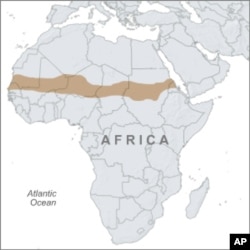Decades of drought in central Africa may have had a surprising cause, according to new research that challenges the notion that the severe dry weather was triggered mainly by bad agricultural practices and overgrazing.
The research, done at the University of Washington, shows that the drought was at least partially caused by pollution in the Northern Hemisphere.
The researchers said that sulfate-laden aerosols coming from coal-burning factories from the 1960s through the 1980s actually slowed warming in the Northern Hemisphere compared to the Southern Hemisphere. This shifted tropical rain bands south, away from the Sahel region, and led ultimately to the near drying up of Lake Chad, which is used to water crops in surrounding areas.
“We think people should know that these particles not only pollute air locally, but they also have these remote climate effects,” said the study’s lead author, Yen-Ting Hwang, a University of Washington doctoral student in atmospheric sciences.
Hwang’s co-author, Dargan Frierson, an associate professor of atmospheric sciences at the University of Washington, said “to some extent, science messed this one up the first time around.”
“People thought that a large part of that drought was due to bad farming practices and desertification,” he said. “But over the last 20 years or so we’ve realized that that was quite wrong, and that large-scale ocean and atmosphere patterns are significantly more powerful in terms of shaping where the rains fall.”
Researchers also studied rainfall in other places on the northern edge of the tropical rain band such as northern India and South America. These areas also experienced less rainfall during the 1970s and 1980s. Meanwhile, areas on the southern edge of the tropical rain band, such as northeast Brazil and the African Great Lakes, saw an increase in rainfall.
The researchers also looked at 26 climate models used by the Intergovernmental Panel on Climate Change, and found that nearly all the models showed some southward shift in rainfall and that slowed warming in the Northern Hemisphere was the “primary cause.”
“One of our research strategies is to zoom out,” said Hwang. “Instead of studying rainfall at a particular place, we try to look for the larger-scale patterns.”
There was a silver lining found in the research.
The study showed that steps taken in the United States and Europe in the 1960s and 1970s to reduce emissions and improve air quality began to improve the situation in the Sahel. While the area still suffers short-term droughts, “the long-term drought began to recover in the 1980s” as the rains began to move north again, according to the research.
“We were able to do something that was good for us, and it also benefited people elsewhere,” Frierson said.
It’s a trend that Hwang says is likely to continue.
As the atmosphere gathers higher levels of greenhouse gases, however, Hwang said the Northern Hemisphere will warm more rapidly than the Southern Hemisphere because there is more land.
“It’s not yet crystal clear what will happen,” she said. “There will be some shift in the tropical rains, and most models predict a northern shift.”
The research, done at the University of Washington, shows that the drought was at least partially caused by pollution in the Northern Hemisphere.
The researchers said that sulfate-laden aerosols coming from coal-burning factories from the 1960s through the 1980s actually slowed warming in the Northern Hemisphere compared to the Southern Hemisphere. This shifted tropical rain bands south, away from the Sahel region, and led ultimately to the near drying up of Lake Chad, which is used to water crops in surrounding areas.
“We think people should know that these particles not only pollute air locally, but they also have these remote climate effects,” said the study’s lead author, Yen-Ting Hwang, a University of Washington doctoral student in atmospheric sciences.
Hwang’s co-author, Dargan Frierson, an associate professor of atmospheric sciences at the University of Washington, said “to some extent, science messed this one up the first time around.”
“People thought that a large part of that drought was due to bad farming practices and desertification,” he said. “But over the last 20 years or so we’ve realized that that was quite wrong, and that large-scale ocean and atmosphere patterns are significantly more powerful in terms of shaping where the rains fall.”
Researchers also studied rainfall in other places on the northern edge of the tropical rain band such as northern India and South America. These areas also experienced less rainfall during the 1970s and 1980s. Meanwhile, areas on the southern edge of the tropical rain band, such as northeast Brazil and the African Great Lakes, saw an increase in rainfall.
The researchers also looked at 26 climate models used by the Intergovernmental Panel on Climate Change, and found that nearly all the models showed some southward shift in rainfall and that slowed warming in the Northern Hemisphere was the “primary cause.”
“One of our research strategies is to zoom out,” said Hwang. “Instead of studying rainfall at a particular place, we try to look for the larger-scale patterns.”
There was a silver lining found in the research.
The study showed that steps taken in the United States and Europe in the 1960s and 1970s to reduce emissions and improve air quality began to improve the situation in the Sahel. While the area still suffers short-term droughts, “the long-term drought began to recover in the 1980s” as the rains began to move north again, according to the research.
“We were able to do something that was good for us, and it also benefited people elsewhere,” Frierson said.
It’s a trend that Hwang says is likely to continue.
As the atmosphere gathers higher levels of greenhouse gases, however, Hwang said the Northern Hemisphere will warm more rapidly than the Southern Hemisphere because there is more land.
“It’s not yet crystal clear what will happen,” she said. “There will be some shift in the tropical rains, and most models predict a northern shift.”









